Curtains in the kitchen should be super-practical and beautiful at the same time. This article and a selection of 100 photo interiors will help you choose the perfect curtain style, plan their design, choose the fabric, decide on the size, and choose the eaves.
Step 1. Choose the type of curtains
There are several varieties of the most common types of curtains for the kitchen: Roman, Japanese, roller, curtain cafes, classic, cotton.
Roman curtains
Roman curtains are a canvas that, thanks to the lifting mechanism (similar to the blinds system), can be raised and lowered, letting in light or shading the room. Rising, the Roman curtain forms uniform folds and folds into an “accordion” (as a rule, only the lower half of the canvas is lifted, but you can find or sew a model that rises completely). Roman blind covers either the entire window opening, or is mounted on the window sash and leaves open the window sill. As a rule, wide windows are curled up not by one, but by several canvases.

Pros: easy to care for, beautiful, but at the same time concise, and therefore suitable for a small kitchen. And yet they are perfectly combined with curtains and classic curtains, look good in both traditional and modern interiors.
Minuses: This type of curtain has a lifting mechanism, which, like any mechanical design, can wear out or break. Since the Roman blinds are short and without lush drapery, it is quite easy to wash and remove them, but this is complicated by the slats of the lifting system, which must be removed before washing. Another nuance is if the ceiling is too close to the upper edge of the window opening or there is no transom at the window (see photo below), and the window sill is narrow, then the Roman curtains will not allow opening the windows for plowing (for this you have to completely remove the curtains from the eaves).

Roman curtains in the design of the window with a transom
Tips:
- Roman curtains can be made with your own hands, following our master class;
- Almost any fabric is suitable for production, except for the pressed and stretching ones;
- Roman curtains are more suitable for decoration of narrow windows than square ones.
See more material: Guide to choosing Roman curtains for the kitchen window.
Roller blinds
Roller blinds - a cloth fabric that twists into a roll and unwinds in a smooth canvas adjacent to the window by fixing the bottom of the curtain to the fishing line guide. The roll can be hidden in the box (cassette model) or remain visible (open model). They are mounted on the wall above the window opening, and directly on the sash.

Open curtains installed inside the window opening


Pros: due to the fixation of the canvas to the guide, roller blinds do not wave in the wind and do not hang down when the window is folded at an angle (or if the window is attic). Roller blinds do not let light through the edges of the window, are easy to clean and are inexpensive. The design of such curtains is laconic, and therefore they fit perfectly into any interiors, especially in modern ones. Since roller blinds do not hide the space, it is good to use them in small kitchens. Another bonus - ready-made roller blinds can be independently adjusted to a non-standard window size.
Minuses: roller blinds mounted on the sash, do not allow to open the window wide open due to the fact that the roll itself rests on the slope of the window niche or in the wall. The second minus - as a rule, roller blinds can be cleaned only by hand, they cannot be washed in a washing machine. The third disadvantage is that most often the roller blinds are made of artificial materials, sometimes they resemble a simple oilcloth. And in general, roller blinds are so minimalistic that they may seem “office”.
Tips:
- When choosing roller blinds for the kitchen, make sure that they are impregnated with antistatic and dirt-repellent compounds.
- Ready-made roller blinds can be customized to fit a custom window size. To do this, you only need to cut the canvas and cut off the excess shaft.
- The use of roller blinds solo is appropriate, perhaps, only in a modern kitchen, for example, Scandinavian style. In the traditional interior it is better to combine them with tulle, curtains or curtains.
- They can be sewn independently from the fabric.
- Dark-colored blinds are not the best idea, as they will be very noticeable dust and dirt.
See more in the material: Blinds in the kitchen - everything you need to know before you buy.
Curtains Cafe
Curtains cafes are short curtains (not lower than a window sill) that are mounted on a telescopic cornice on a sash in the middle of the window (less often - at the top of the opening).
Pros: they look very comfortable, due to their small size they are easy to clean, they do not hide space.
Minuses: not suitable for modern interior, a little shade the space.
Tips:
- Curtains cafes can be made independently using our step-by-step instructions (see the link below).
- Especially great these curtains are combined with lambrequin.
For details, see the material: Curtains in the style of a cafe for the kitchen - choose ready or sew themselves?.
Panel Curtains (Japanese)
Japanese curtains for the kitchen are sliding fabric panels - they move along the guides like the doors of the wardrobe.
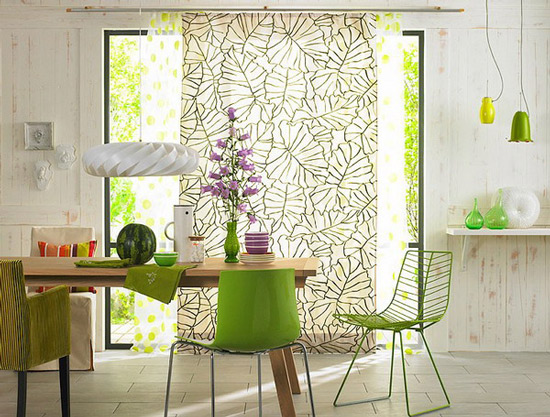

Pros: Japanese curtains are well suited for a kitchen with a balcony door and / or large windows. They are easy to manage, can be remotely controlled (this is especially true for very tall windows). It is easy to care for them thanks to antistatic impregnation: all you need to do is wipe cloths from time to time with a cloth. Due to its length in the floor panel curtains visually raise the ceiling, and due to the lack of folds - do not overload the interior, therefore, are suitable for small kitchens.
Minuses: panel curtains are good in a modern interior, and in the classic - hardly.
Tip:
- Japanese curtains can be used as a screen, if you want to divide the combined space into zones, for example, kitchen-living room or kitchen in a studio apartment.
Curtains of filaments (muslin)
Curtains Kis are a curtain of threads (fabric or beaded).

Pros: It looks unusual and light, suitable for ethnic interiors and art deco kitchens.
Minuses: If you have pets or small children, the thread curtains will not work for you, as they are easily torn, and the beads can be scattered and swallowed.
For details, see the material: Curtains-threads in the kitchen - the choice, care, making their own hands.
Jalousie
Blinds consist of woven or non-woven (aluminum, bamboo, plastic or wood) lamellae, which, due to their mechanism, can not only assemble and open, but also rotate around their axis. Thus, they allow you to adjust the shading from strong to weak. Blinds are vertical and horizontal. Horizontal blinds are made of plastic, bamboo or wood (less often). The lamellas of vertical blinds, as a rule, are made of synthetic material and impregnated with dirt-repellent compounds.
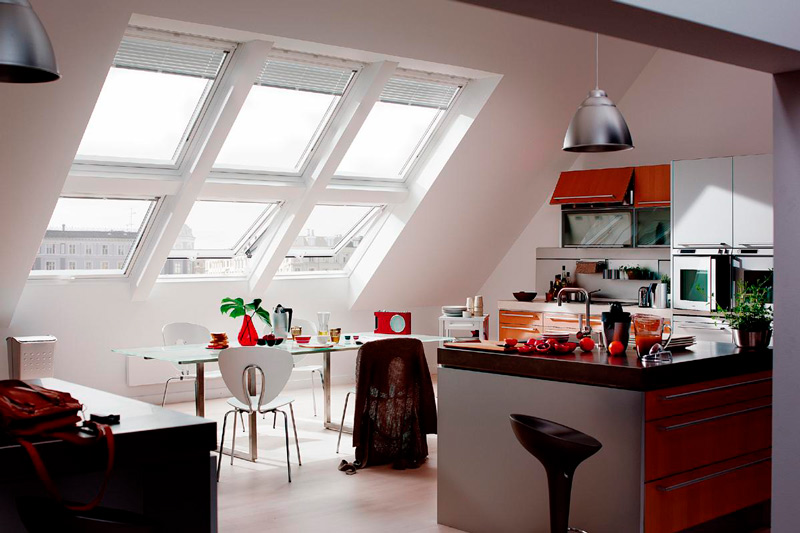
Horizontal blinds on the skylights

Vertical blinds in the interior of the kitchen

Aluminum Blinds
Pros: good shading and the possibility of its regulation, as well as ease of care.
Minuses: somewhat "office" look.
For details, see the material: Blinds in the kitchen - a step by step guide of choice and 45 photos.
Classic curtains (curtains, tulle)
Classic curtains do not need to be introduced, because this style is the most popular and familiar. The curtain assembly is most often formed by a curtain tape (it can be of different kinds), and they are attached to the eaves on eyelets, loops, hooks or rings with crocodiles.

Curtains with grommets
Pros: curtains from one or two canvases are universal and suitable for both classic and modern kitchens. Unlike roller and panel curtains, as well as blinds, classic curtains have folds, so they are guaranteed to bring comfort to the interior. Due to the abundance of fabrics, curtain accessories, the possibility of choosing the length of the canvases and the density of the assembly, it is possible not only to create a unique window design, but also to correct some of the room’s drawbacks. For example, with the help of long curtains, you can hide pipes, a balcony door or a radiator.
Minuses: Classic curtains are somewhat tedious to remove and hang, wash and iron. Since they are sewn from ordinary fabrics, they tend to get dirty quickly, soak in fat and the smell of food. It is not always convenient to control them - fastenings often slide badly along the eaves.
Tips:
- Classic curtains can not be hung close to the stove, because they can fly up to the fire from the wind and ignite. In addition, it is simply not practical - a splash of fat will fill the fabric.
- For a small kitchen you should choose short curtains with easy assembly. It is desirable that the fabric was soft, then the folds will turn out even and neat.
- Floor length is recommended for large kitchens, as well as for kitchens with a balcony door.
See also: How to choose curtains for the kitchen with a balcony door - 4 solutions
Step 2. Choose the color and pattern of the fabric
Here are some tips to help you choose curtains for the kitchen of the right color:
- Most often, the curtains are selected to match the walls, to the tone of the facades of the kitchen, apron, or to match the rest of the kitchen textiles, for example, under the upholstery of chairs, under the pillows, napkins, and more.

Purple curtains in harmony with kitchen accessories

Red curtains to match kitchen apron
- The most versatile curtain color is white (and its shades);
- If the kitchen does not have enough sunlight, choose curtains of a warm color, for example, creamy or yellow, as in the photo below.
But tips on choosing fabric print:
- The pattern on the curtain fabric can overlap with the wallpaper, apron, floor covering, carpet, wall decor and other textiles in the room.
- Keep in mind that a large pattern visually reduces the space, so for small kitchens it is better to choose curtains with unobtrusive and small patterns / patterns.
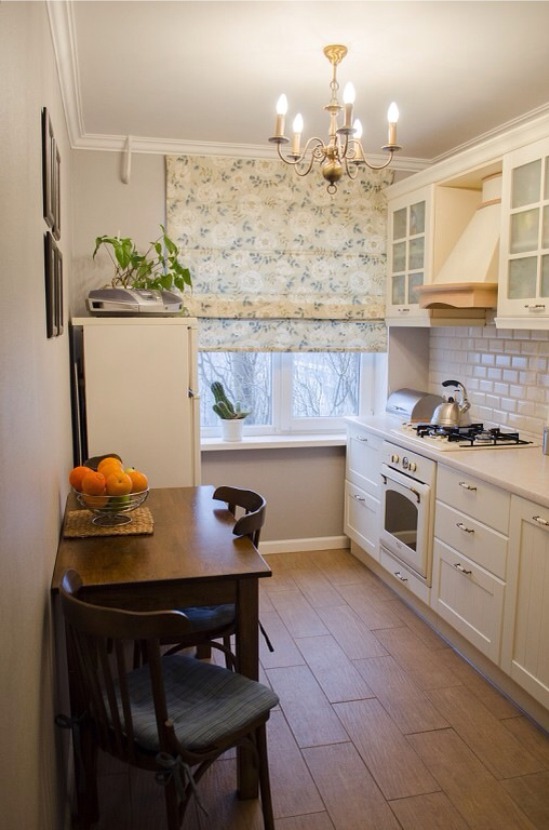
- If the ceiling is low, choose vertical striped or diamond-shaped curtains as shown in the photo below. Also suitable vertical blinds, panel curtains and classic canvas to the floor, collected in a smooth and crisp folds.

Curtains in a diamond in the kitchen with a balcony door
- If the kitchen is small and narrow, then Roman, roller and panel curtains with horizontal stripes (seephoto below) or horizontal blinds.


- For classic kitchens suitable curtains with a traditional print, for example, in a cage, with a floral, floral or heraldic pattern / patterns.

Classic style curtains
- The windows of the modern kitchen can be decorated with curtains with any geometric or abstract pattern.

Curtains in the interior of a modern kitchen-living room
Step 3. Determine the size
As a rule, the cornice is installed at a distance of 20-25 cm from the upper edge of the window niche or on the ceiling. But the length of the kitchen curtains can be different:
- Very shortwhen the canvas lacks about 1 cm to the window sill. This length is suitable if the window sill is used as a bar counter or cutting tableand also when fastening the curtain inside the window opening.

- Shortwhen the web hangs down about 10 cm below the sill. This length is suitable for small kitchens.
- Longwhen the canvas lacks 1 cm to the floor or touches it. Especially suitable for large kitchens and for the decoration of windows with a balcony door.
- Very longwhen 5-10 cm of fabric lie on the floor. Such curtains are more suitable for decoration of windows of classic interior. kitchen-dining room or kitchen-living room.

With regard to the choice of the width of the kitchen curtains, here the recommendation is the same - the canvas should go on the wall at 20-26 cm on both sides of the opening.
Step 4. Choose a material
Cotton and linen fabrics, fabrics made of viscose and polyester, as well as blended fabrics of natural and synthetic fibers are suitable for sewing kitchen curtains. But from silk and wool is better to give up - they are too capricious and are suitable only for the decoration of the windows of the dining room.
- Linen - an excellent material for kitchen curtains, because it is durable, has a beautiful texture, tolerates frequent washing and is resistant to fading. However, it is expensive, quickly wrinkled and sits down heavily after washing. When buying ready-made linen curtains or fabric for sewing, you need to take into account the margin of length for shrinkage.
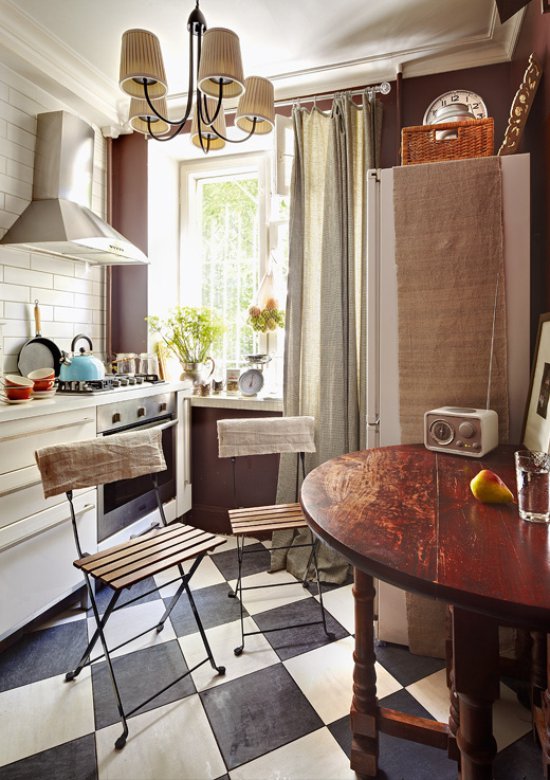
- Cotton beautiful, strong enough, but wrinkled when pure, shrinks after washing and burns out in the sun. Therefore, fabrics made from 100% cotton should prefer polycotton (polyester and cotton) or complement cotton lining (from the same cotton).
- Viscose (modal, lyocell) - This is a budget and more practical alternative to silk, but it does not tolerate frequent washings, as it is afraid of water. When choosing curtains for the kitchen from this material, give preference to models with polyester in the composition and / or combine curtains with lining.
- Polyester Fabrics cost inexpensively, do not crumple, do not shrink, and do not fade from UV rays. But they attract dust and strongly lose to natural materials in beauty.
Tip: It is good if the kitchen curtains will have a lining that protects the main fabric from burning in the sun. In addition, the lining allows you to hide the internal seams, helps to form voluminous folds, if the fabric is light, will improve the insulation and acoustics of the kitchen.
Step 5. We select the eaves
The cornice is as important as the curtains themselves, because the reliability of the whole structure and the beauty of the window design depend on them. Cornices are ceiling and wall - in the form of tires with rails, rods or string system.
- The standard length of the cornice should be 30% greater than the width of the window. But if you need to visually expand the window opening, then it is worth picking up the eaves even longer. Conversely, if the window is too wide, then the length of the eaves should be about the same as the width of the opening. If you plan to hang short curtains inside the window opening, then the length of the cornice should be 2–3 cm less.
- In order for the cornice to hang securely and not bend under the weight of curtains, it is necessary to correctly calculate the number of bracket holders. This will help you to the recommendations of the manufacturers attached to the eaves.
- The heavier the curtains, the more rigid the profile cornice and its runners must be. Or wider diameter when it comes to the bar.For a moderately heavy construction, a rod with a diameter of 2 cm is suitable; for heavy curtains, a rod with a diameter of 2.8 cm.
- Ceiling cornice - the most subtle, and therefore universal. Moreover, due to the uniform load distribution, it is very reliable and suitable for heavy curtains. True, it can only be installed on a concrete base and, best of all, from wall to wall (otherwise it should be hidden behind a decorative cornice).
- Wrought and wooden bars are good for "village" kitchens (for example, decorated in Provence style, country, chebbi chic). Bronze and brass cornices with elegant tips - for classic. For the kitchen, decorated in a modern style, the bar is also suitable, especially in combination with the curtains on the grommet as in the interior in the next photo.
- If the interior of the kitchen is decorated in a modern style, and the curtains are light and not long, the string cornice will work well.
- Curtains-cafes are hung on special stained glass cornices or mini-rods installed in the strut in the window casements.
- For the design of non-standard windows (arched, corner and bay), you must select a special profile plastic or aluminum cornices.
- Guide to choosing a curtain rail for kitchen curtains and installation instructions
- 10 window decoration ideas for the Provence style kitchen
- Curtains-arch for the kitchen - a master class on sewing and tips on choosing a design
- Everything you need to know about kitchen tulle
- How to choose the perfect short curtains for the kitchen
- Knitted curtains for the kitchen

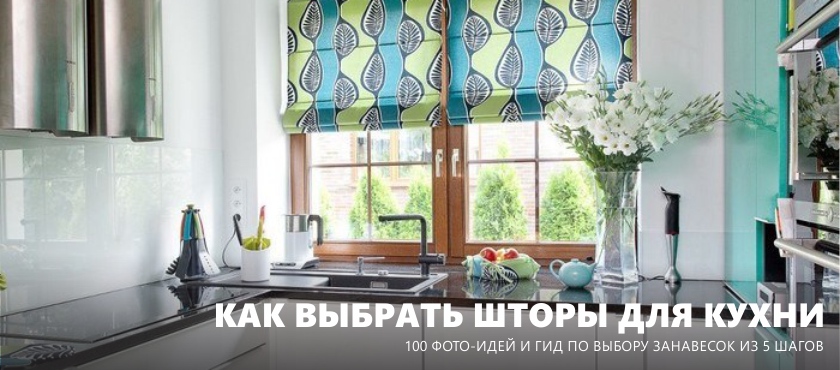





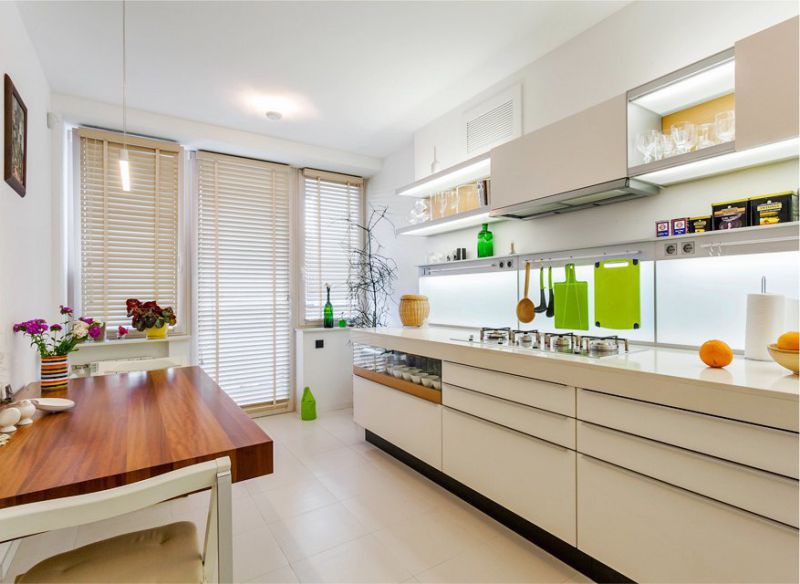








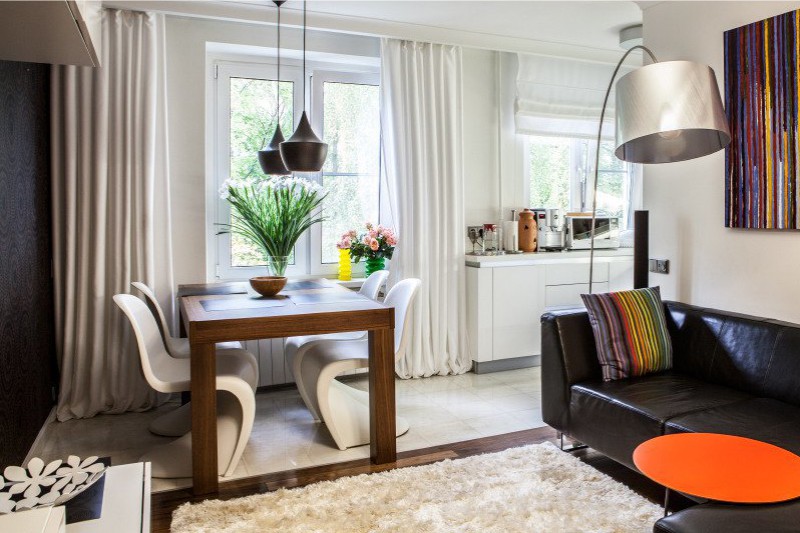





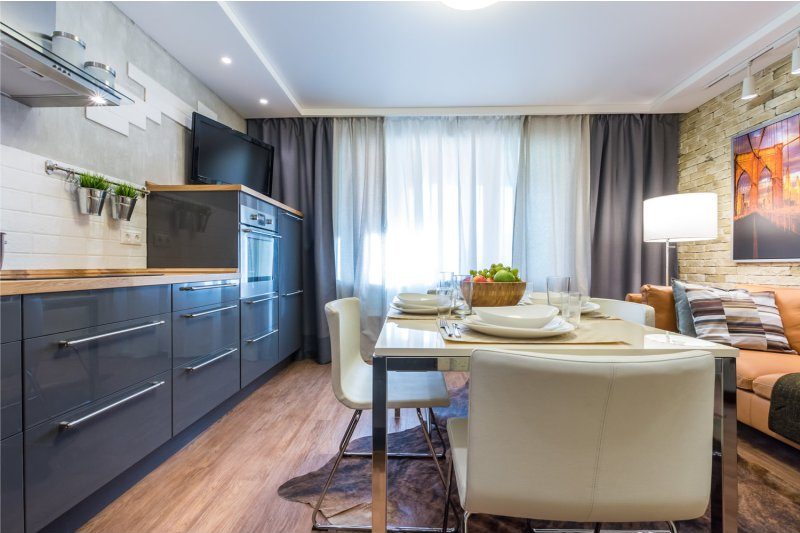


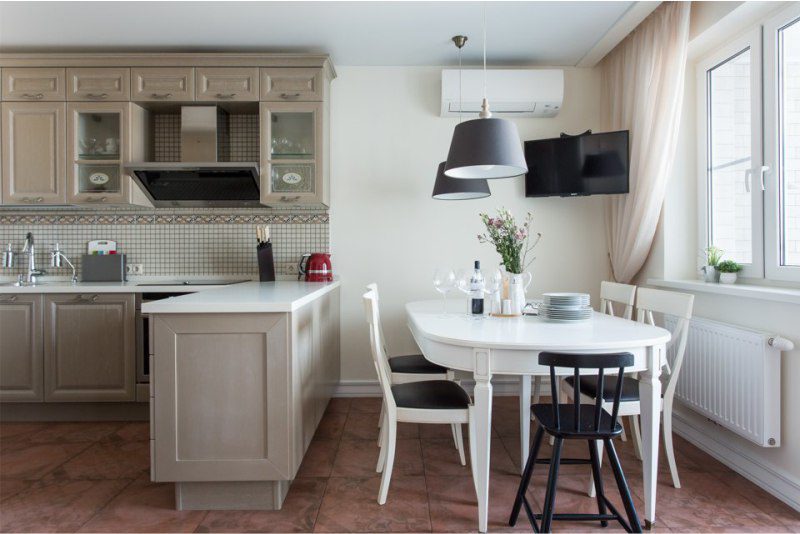













 (Rate the material! Already voted:41 average rating: 4,46 from 5)
(Rate the material! Already voted:41 average rating: 4,46 from 5)
Beautiful curtains in the kitchen! Especially liked the Roman blinds, look
stylish and not bulky. I agree with the author! Kitchen curtains should
easy to shoot, it really significantly reduces the time for
cleaning up!
Great article. The tips helped a lot. I ordered an Italian curtain fabric ale-ko. ru The perfect fabric